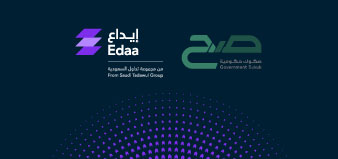Z7_K8M0I840299IE0QV98G4LN00C6
 Web Content Viewer
Web Content Viewer
Edaa Launches ‘Edaa Connect’ to Simplify Access to Saudi Mutual Funds
For MoreElevate Your Meeting Experience with Liqaa Service
For MoreOur Services
Transfers
Transfer shares from one account to another or from one shareholder to another.
Explore ServiceEmployee Compliance Service
Monitor employees’ activities on the Saudi Stock Exchange through the Tadawulaty portal.
Explore ServiceGeneral Meetings Management
Seamlessly count and combine votes and validate the identities of eligible shareholders.
Explore ServiceRegistrar Management
The day-to-day administration of registrar operations and associated corporate actions.
Explore ServiceTawasul
An interactive solution for issuers to maintain communication with their shareholders.
Explore ServiceAccounts & Transfers
Set up Center Accounts and transfer ownership from one account to another.
Explore ServiceGeneral Meetings Management
Seamlessly count and combine votes and validate the identities of eligible shareholders.
Explore ServiceRegistrar Management
The day-to-day administration of registrar operations and associated corporate actions.
Explore ServiceCertificate Search
Edaa offers a “Shares Certificates Search Service” that allows shareholders to inquire about their certificate’s ownership.
Certificate SearchTadawulaty

Tadawulaty is a platform that provides a suite of services offered by Edaa in conjunction with custody members. It incorporates a bundle of new financial support services targeting different segments of investors and participants.
Recent Updates
Latest News & Announcements
Get To Know Us
Read about our experienced management team.
Contact Us
Interested in Tadawulaty and our services? Get in touch with one of our experts.
Ecosystem

Saudi Tadawul Group
Our parent company that houses a portfolio of four integrated subsidiaries: The Saudi Exchange, Edaa, Muqassa, and Wamid.

Saudi Exchange
Provides reliable, resilient, transparent & efficient markets and offers tailored services for domestic and international investors and issuers.

Muqassa
Guarantees trades made on the Saudi Exchange and provide clearing services for financial derivatives.

Wamid
Offers sophisticated data and technology services to support the growth of the Saudi capital market.
Z7_88AAH00239S3406EM018LT00G0
 EdaaNewsletterPortlet
EdaaNewsletterPortlet
Z7_O9HCHI014P40B06H7SV3GD10D7
 EDAALatestNewsAndAnnouncements
EDAALatestNewsAndAnnouncements
Copyright © 2025 - Edaa
Complementary Content
- ${title}${badge}
${loading}










